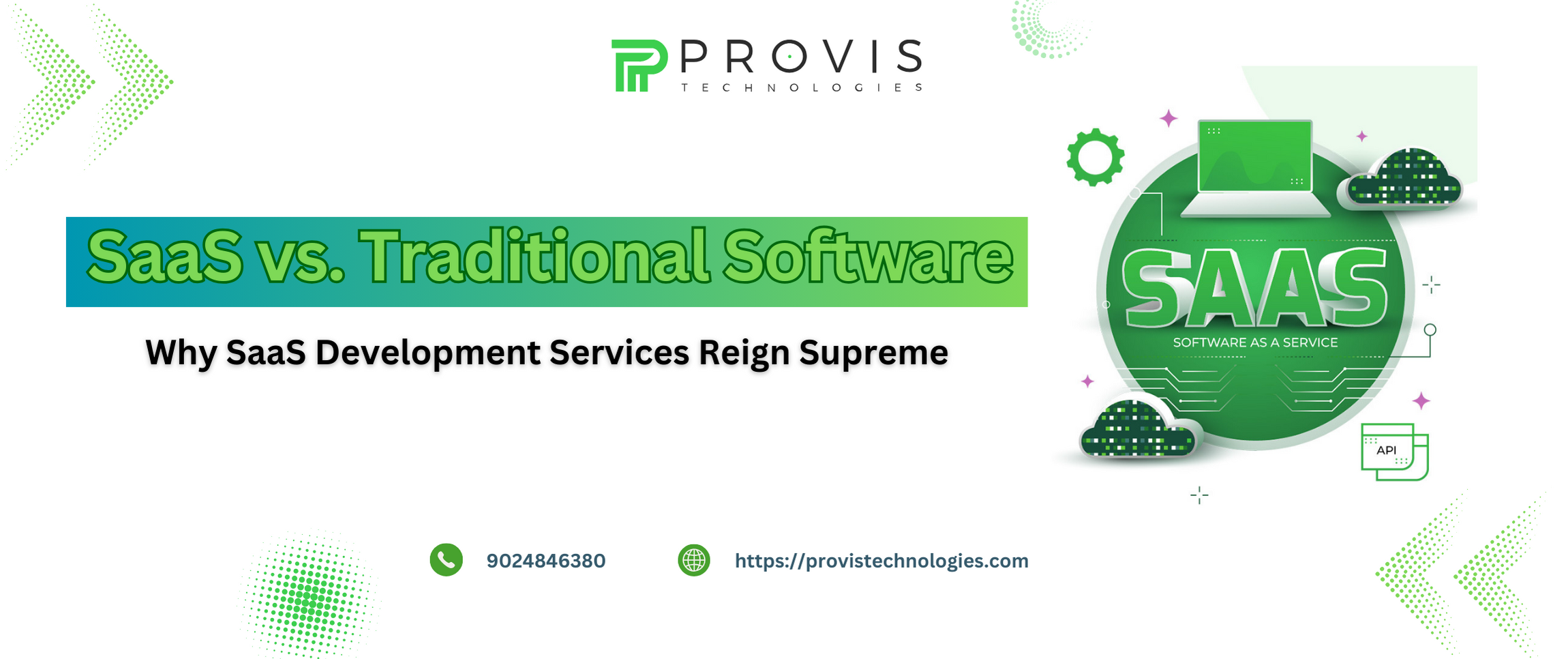The software space has witnessed a remarkable transformation over the past few years. Traditional software applications, once dominant, are now becoming endangered due to cloud-based applications, i.e., Software-as-a-Service (SaaS). SaaS development services are rapidly gaining ground and are often the preferred choice for businesses of all sizes. In this story, we will take a deep insight into the differences between SaaS and traditional software. We will also discuss why SaaS development services are outshining the software industry.
Accessibility & Convenience
One of the fundamental reasons SaaS development services have taken the lead over traditional software is the accessibility & convenience they offer. With the latter, users must purchase a license, install the software on their local machines, and regularly update it. In contrast, SaaS applications are cloud-based and accessible from any device with an internet connection. Users can access their SaaS tools without the need for installations or manual updates, making them incredibly convenient for both businesses and individuals.
Cost-Effective Solutions
SaaS development services offer a cost-effective alternative to traditional software. Traditional software often requires significant upfront costs for licenses, hardware, and infrastructure. Additionally, ongoing expenses include maintenance, updates, and support. SaaS, on the other hand, follows a subscription-based model, which typically includes all these costs within a single, reasonable fee. This subscription model allows businesses to budget more effectively and avoid unexpected expenses, making SaaS a financially attractive choice.
Scalability & Flexibility
SaaS development services provide unmatched scalability & flexibility. Traditional software often comes with limitations in terms of user licenses & functionality. Expanding or customizing them can be costly & time-consuming. However, SaaS applications are designed to scale effortlessly – with the ability to add or remove users as needed. Also, many SaaS solutions offer various plans & features that can be tailored to a business’s specific needs. This makes SaaS the preferred choice for businesses that need to adapt quickly to changing market demands.
Automatic Updates & Maintenance
With traditional software, keeping the application updated and addressing maintenance issues is a responsibility that users must take care of. This can be time-consuming and irritating. With SaaS, the service provider takes care of updates & maintenance. This hands-off approach allows businesses to focus on their core operations while enjoying the benefits of a well-maintained and up-to-date software ecosystem.
Don’t Miss: How to Develop a SaaS Application? | The Complete Guide
Collaboration & Integration
SaaS development services excel in enabling collaboration & integration among various software tools. Traditional software cannot often smoothly integrate with other applications as they require additional development work & resources. SaaS applications are designed to be integrated, allowing businesses to connect various tools and streamline workflows. This feature is invaluable in today’s interconnected business domain, where the ability to share data and collaborate in real time is a competitive advantage.
Enhanced Security & Data Protection
Security is a top concern for any organization. SaaS development services have significantly improved in terms of security & data protection. SaaS service distributors take care of encryption, access controls, regular security audits, and overall system security through best-in-class technology. This often surpasses the security measures that individual organizations implement for traditional software. By entrusting their data to reputable SaaS providers, businesses can benefit from world-class security.
Disaster Recovery & Redundancy
Disaster recovery and data redundancy are vital aspects of any software solution. SaaS development services are typically hosted in secure data centers with multiple redundancies and backup systems. This ensures data integrity and availability even in the face of unforeseen disasters. Traditional software, when deployed on local servers, may lack the same redundancy and disaster recovery options, which makes them vulnerable to data loss & downtime.
Rapid Deployment
SaaS services offer rapid deployment to enable fast business operations. Traditional software often involves a lengthy installation and setup process that leads to downtime. With SaaS, users can log in and start using the software immediately. This speed of deployment is especially advantageous for new businesses and those looking to stay fast in a competitive market.
Global Access & Remote Work
The global workforce is becoming increasingly mobile – and the pandemic has accelerated the shift toward remote work. SaaS development services are ideally suited for this trend, as they can be accessed from anywhere in the world with an internet connection. This remote accessibility allows people to work from different locations. Traditional software, which may be tied to specific machines or places – can hinder this level of flexibility.
Regular Feature Updates
SaaS applications are renowned for their continuous improvement and innovation. SaaS providers frequently release feature updates and enhancements to ensure their software remains relevant & competitive. Traditional software, in contrast, often receives infrequent updates, as they require significant development & distribution efforts. This means that users may miss out on valuable features & improvements.
Conclusion
The debate between SaaS development services and traditional software is not about which is inherently superior but which is more suitable. However, the advantages of SaaS are hard to ignore, and it’s clear that SaaS is gaining the upper hand in the software industry. Accessibility, cost-effectiveness, scalability, automatic updates, and enhanced security are compelling reasons why SaaS development services have become the preferred choice for businesses & individuals. As technology continues to evolve, the dominance of SaaS will likely continue to grow as it offers new opportunities for users across the globe.
Written By
Author's Picks
- 30 FAQs About SaaS Product Development
- 29/08/2024
- Identifying SaaS Potential Threats & Mastering the Art of SaaS Support
- 24/01/2024
- Top 15 Software Development Trends to Follow in 2025
- 31/01/2025
Categories
- AI for Startups
- AI in Web Development
- AI Integration
- AI Platforms
- AI Prompt
- AI Tools
- AI Trading Software
- Android App
- Android vs iOS Development
- Angular
- API
- API Development
- App
- app development
- App Idea
- App User Feedback
- Application
- Artificial Intelligence
- Audit Services
- Automotive Industry
- Awards and Recognition
- Business Consulting
- Business Website
- Chatbots
- CRM
- CRM for Financial Advisors
- Custom CRM
- Custom SaaS
- Custom Website
- Customer Service
- dashboard design
- Developing a Mobile App
- Digital Business
- E-commerce
- EMR Integration
- Finance
- Financial Advisors
- Financial Advisors
- GIT
- Health Insurance
- iOS App
- iOS App Development
- IoT Mobile App Development
- IoT Platforms
- IT Audit Services
- IT Consulting
- IT Strategies
- Java Development
- Laravel
- Lean Canvas
- Learning Management System
- Logistics Apps
- Mobile App Development
- MVP
- Native App
- News Aggregator Site
- OTT
- Outsourcing IT
- Payment Gateway
- predictive analysis
- Product Launch Strategy
- Progressive Web App (PWA)
- Prototype
- Recommender Systems
- Ruby
- SaaS
- SaaS Application
- SaaS Business
- SaaS Company
- SaaS Development
- SaaS Product
- SaaS Project
- Sales Funnel
- SEO
- Shopping Cart
- Software Development
- SSL and TLS
- Startup Checklist
- Technology
- Tetradic Color Scheme
- UI/UX Design Company
- Unit Testing
- User Flow
- User Testing
- Web Development
- Web Performance Optimization
- website Maintenance Services
- Website Migration Service
- Website Speed Optimization
- WooCommerce
- WordPress





